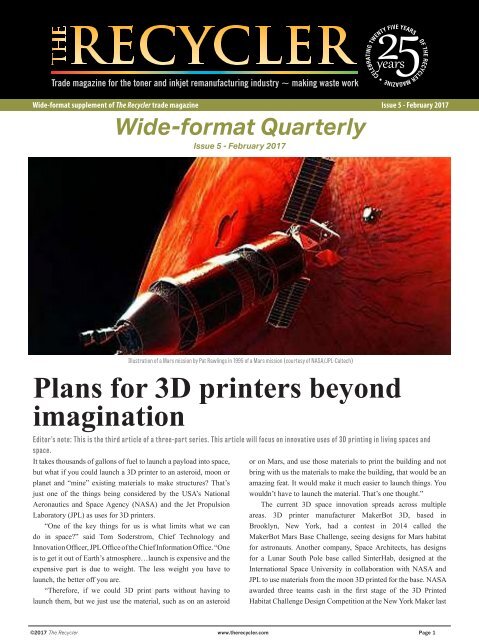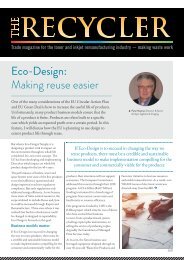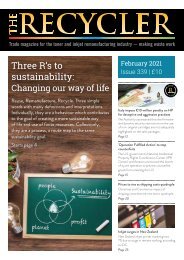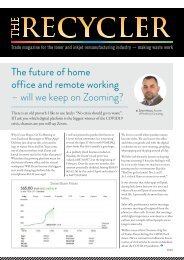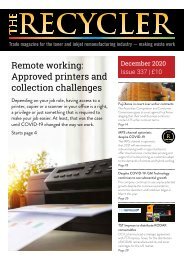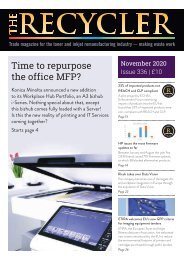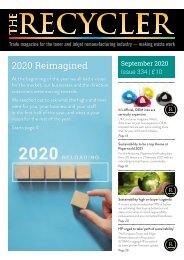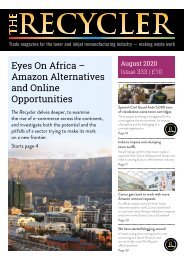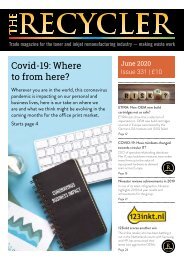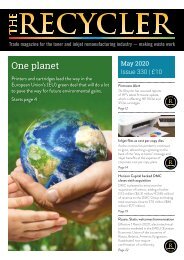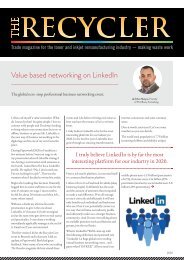Wide Format news 1-2017
You also want an ePaper? Increase the reach of your titles
YUMPU automatically turns print PDFs into web optimized ePapers that Google loves.
years<br />
CELEBRATING TWENTY FIVE YEARS<br />
OF THE RECYCLER MAGAZINE<br />
•<br />
<strong>Wide</strong>-format supplement of The Recycler trade magazine<br />
<strong>Wide</strong>-format Quarterly<br />
Issue 5 - February <strong>2017</strong><br />
Issue 5 - February <strong>2017</strong><br />
Illustration of a Mars mission by Pat Rawlings in 1995 of a Mars mission (courtesy of NASA/JPL-Caltech)<br />
Plans for 3D printers beyond<br />
imagination<br />
Editor’s note: This is the third article of a three-part series. This article will focus on innovative uses of 3D printing in living spaces and<br />
space.<br />
It takes thousands of gallons of fuel to launch a payload into space, or on Mars, and use those materials to print the building and not<br />
but what if you could launch a 3D printer to an asteroid, moon or bring with us the materials to make the building, that would be an<br />
planet and “mine” existing materials to make structures? That’s amazing feat. It would make it much easier to launch things. You<br />
just one of the things being considered by the USA’s National wouldn’t have to launch the material. That’s one thought.”<br />
Aeronautics and Space Agency (NASA) and the Jet Propulsion The current 3D space innovation spreads across multiple<br />
Laboratory (JPL) as uses for 3D printers.<br />
areas. 3D printer manufacturer MakerBot 3D, based in<br />
“One of the key things for us is what limits what we can Brooklyn, New York, had a contest in 2014 called the<br />
do in space?” said Tom Soderstrom, Chief Technology and MakerBot Mars Base Challenge, seeing designs for Mars habitat<br />
Innovation Officer, JPL Office of the Chief Information Office. “One for astronauts. Another company, Space Architects, has designs<br />
is to get it out of Earth’s atmosphere…launch is expensive and the for a Lunar South Pole base called SinterHab, designed at the<br />
expensive part is due to weight. The less weight you have to International Space University in collaboration with NASA and<br />
launch, the better off you are.<br />
JPL to use materials from the moon 3D printed for the base. NASA<br />
“Therefore, if we could 3D print parts without having to awarded three teams cash in the first stage of the 3D Printed<br />
launch them, but we just use the material, such as on an asteroid Habitat Challenge Design Competition at the New York Maker last<br />
©<strong>2017</strong> The Recycler www.therecycler.com Page 1
Space recyclers<br />
The MakerBot 3D printing company, in partnership with NASA, had a contest in 2014 called the MakerBot<br />
Mars Base Challenge, seeing designs for Mars 3D-printed habitat for astronauts. This design by Noah<br />
Hornberger won first prize<br />
September.<br />
Structures are also contemplated for earth habitat. The UN<br />
estimates that approximately three billion people will need<br />
housing by 2030. Italian engineering company WASP has<br />
constructed a 40 by 20 foot (approximately 6 by 12 metre) 3D<br />
printer that layers clay and builds houses. The project, consisting<br />
of a metal frame suspending a nozzle, is expected to help solve the<br />
global housing crisis with sustainable materials.<br />
For now, actual printers capable of 3D printing in zero-gravity<br />
are smaller. The first zero-gravity printer from NASA/JPL partner<br />
Made in Space was launched on 21 September 2014 as part<br />
of a pack of experiments. The device, tested on a specially-made<br />
aircraft to simulate zero-gravity flight and sent to the International<br />
Space Station, built an ABS-plastic ratchet wrench later tested<br />
on the ground, but proved its value in building tools and parts as<br />
second-generation zero-gravity 3D printers are being devised.<br />
“We are actively researching traditional methods and novel<br />
techniques that use extraterrestrial regolith simulants as feedstock<br />
for additive manufacturing,” said Brad Kohlenberg, Business<br />
Development Engineer for Made In Space, based in Mountain<br />
View, California. “We expect these efforts to help in the overall<br />
goal of making humanity a multi-planetary species. Ultimately,<br />
our participation towards that end could take many forms.”<br />
The Additive Manufacturing Facility by Made in Space was<br />
installed at the International Space Station in April 2016, and this<br />
3D printer will print with a wide range of polymers, is designed<br />
to last the entire lifetime of the space station, and is commercially<br />
available for any customers on Earth who wish to get hardware<br />
into space.<br />
Now that Made in Space has demonstrated technical ability<br />
and built relationships with partners, Kohlenberg said “we are<br />
looking to finally do the things we dreamed about when we started<br />
the company - building the necessary infrastructure for human<br />
spaceflight, in space. That infrastructure could entail everything<br />
from on-demand satellites and habitats to space elevators and<br />
kilometre-scale colony ships.<br />
“As these manufacturing technologies become more<br />
sophisticated and as we reach further away from Earth, Made<br />
In Space imagines a future in which advanced in-situ resource<br />
utilisation and additive manufacturing techniques allow us to use<br />
the resources we find out in space, rather than having to bring<br />
everything we need with us, allowing us to live sustainably and<br />
permanently off-world”.<br />
Pat Carey, Vice President of Go-to-market Strategy and<br />
Programmes for Stratasys, based in Eden Prairie, Minnesota,<br />
says any technology goes through goes through a curve of early<br />
adopters, then mass adoption, which becomes more affordable<br />
because of the volume. All technology follows the same curve, he<br />
said, and with 3D printing, “we’ll follow that same curve and there<br />
will be innovations we can’t imagine that will come out”.<br />
A recycling project called R3DO is a material reclaimer by<br />
Made In Space to reuse material for printing a 3D-printed object<br />
when the original objects breaks or is obsolete. JPL’s Soderstrom<br />
saw similar projects at an electronics show about three years ago:<br />
“In order for us to be able to print in space, we have to be able<br />
to recycle the material…that’s going to be a key to the future,<br />
especially in space.”<br />
Reprinting parts<br />
The recent movie, The Martian, starring Matt Damon, showed<br />
the need for parts in space. “When things go wrong and all of a<br />
sudden, you need something, how do you get it in space?”<br />
Soderstrom said. “It’s not an easy thing. You’ve got to have a<br />
launch vehicle; you have to know what you need, and by that time,<br />
days and days have gone by. What if you could just reprint that<br />
part? We’ve demonstrated that with NASA using Made In Space.<br />
It’s usually made out of ABS plastic, but it shows that it’s possible<br />
to do that.”<br />
It will mean better handling emergencies with speed, he said,<br />
adding: “It’s extremely important for logistics.”<br />
Kohlenberg said ongoing developments that will make 3D<br />
printing more practical on earth are the same things that will make<br />
An artist’s conception of a Mars base (NASA/JPL public domain)<br />
©<strong>2017</strong> The Recycler www.therecycler.com Page 2
it more practical in space. “Namely, faster speeds, increasing the<br />
range of materials, improving the integrity of printed parts, and<br />
making it easier to use. However, some things like ease of use<br />
are actually less important in space because the zero-G 3D printer<br />
is almost entirely remotely operated by experts. All the astronaut<br />
need do is say, ‘I need such and such’ and the ground teams will<br />
use the printer to make it so.”<br />
materials.”<br />
NASA/JPL is seeking partnerships with companies and<br />
universities to make new materials for 3D printing, which is a<br />
commercial development, Soderstrom added. There is quality<br />
assurance with materials to validate that the material will work.<br />
“One of the most interesting things is that when we send<br />
something into space, it’s extremely risky, so we demonstrate that<br />
it’s going to work as much as we can. So there is a lot of QA. We<br />
will x-ray the materials to assure there’s no problem with it.”<br />
Borgonia said that polymers are a good “show and tell” toy,<br />
but can 3D-printed titanium parts behave similar to the wrought<br />
version of the material? It’s something JPL is working with the<br />
America Makes Consortium to determine (so far, titanium does<br />
behave similarly).<br />
Dramatic innovation<br />
LavaHive, designed by the LavaHive team in the 3D Printed Habitat Challenge Design<br />
Competition, won third place in the NASA-awarded competition, using a ‘lava-casting’<br />
construction<br />
Changing methods<br />
An engineer designing a component of part with subtractive<br />
manufacturing is classically trained to understand how to do<br />
it, said John Paul Borgonia, Technologist at JPL Materials<br />
Developments and Manufacturing Technology Group.<br />
“There are some limitations to that type of manufacturing,”<br />
Borgonia said. “With additive, it completely changes their way<br />
of thinking as engineers, because there are features that would<br />
not have been possible to add to the hardware without additive<br />
manufacturing. Take, for example, I want a particular structure.<br />
Now, I want the actual inside of that structure to be cellular. With<br />
additive manufacturing, those features can be added.”<br />
In space, materials become important as it is super-hot and<br />
super-cold and airless, so they have to handle all that, Soderstrom<br />
noted. Now robots that fly, swim and climb are being made with<br />
more speed, in contrast to the delay in sending out plans and would<br />
take a week to come back. “This cycle that used to take weeks,<br />
now that we have the multi-material printer in house, that cycle<br />
that used to take six weeks is now a day and a half.”<br />
Soderstrom says innovative things are being done with 3D<br />
printing of food. One of his favourite devices is the “Star Trek”<br />
replicator. “How<br />
far away is that? It<br />
may not be that far.<br />
It all comes down<br />
to material, and I<br />
think being able to<br />
experiment with<br />
new materials is<br />
something that’s<br />
extremely important<br />
Jason Dunn, CTO of Made In Space (foreground) and Mike<br />
Snyder, Director of Research and Development (background) work<br />
on the 3D printer sent to operate in the microgravity of the<br />
International Space Station (courtesy of Made In Space)<br />
for us in space and<br />
here at JPL. We at<br />
JPL are working<br />
quite heavily now<br />
by looking at new<br />
Soderstrom says now, designs can be done over the internet with<br />
programmes through Thingiverse or similar websites, and with<br />
social networks, there is a collaboration that has never been done<br />
before. He says 3D printing is enabling us being on “the very cusp<br />
or dramatic innovation”. Kohlenberg says with the research efforts<br />
at Made In Space, they hope to expedite humanity’s ability to<br />
survive any potential future events that could jeopardise life on<br />
earth.<br />
“As we develop solutions for living sustainably in space, we<br />
can take those lessons of sustainability back to earth and better live<br />
on a planet with finite resources. In the very near term, we hope<br />
that our research leads to more products like Made In Space - Fibre<br />
On the right is the 3D printer by Made In Space launched to the International Space<br />
Station in 2014, and on the left is an electronics box that supplies power and stores data.<br />
The printer was deemed successful in 3D zero-gravity printing, and another larger 3D<br />
printer is currently at the ISS (courtesy of Made In Space)<br />
Optics with clear and tangible economic benefits that can further<br />
enable our long term vision.”<br />
Soderstrom says it’s about future thinking, with one of the<br />
key things considering how 3D printing can help NASA/JPL<br />
stakeholders - the public.<br />
“In fact, it’s all of humanity. Being able to engage the public<br />
and all of humanity in the idea of ‘What could we do with 3D<br />
printing?’ is one of the goals, and we’ve had quite a few of those<br />
already, but I think we’re just scratching the surface. All of the<br />
innovation that is happening in 3D printing in industry and homes<br />
throughout the world and in universities is really going to help us<br />
a lot.”<br />
©<strong>2017</strong> The Recycler www.therecycler.com Page 3
Dom Perignon prices for wide-format ink?<br />
Try a third party<br />
Alternatives to expensive original equipment manufacturer inks are an attractive option when ink is more expensive than champagne or<br />
expensive perfume. A Consumer Reports magazine 2013 study shows OEM printer ink as costly as top champagnes and pricey perfumes.<br />
Legitimate suppliers in the wide-format third-party ink<br />
industry successfully frame their inks as an alternative to the<br />
champagne-like OEM prices. Some have succeeded in ink that<br />
retain its colour, can “hot swap” and work in the machines<br />
perfectly. But some small businesses have been burned by ruined<br />
printheads or drifting colours in prints from inferior ink. Vetting a<br />
legitimate supplier is important and easy in this internet age.<br />
Small businesses usually have the option to experiment<br />
with third-party ink for wide-format machines. Aqueous-ink<br />
technology allows the business to easily print high-quality prints<br />
that range from photography to indoor graphics and posters to<br />
banners with low cost, extended colour gamut range and easy<br />
drying and lengthy colour-fastness. OEMs such as Canon, HP Inc<br />
and Epson continue to produce versatile machines using aqueous<br />
inks producing vibrant output on diverse media.<br />
With the advent of water-based latex inks, also available as<br />
third-party ink, the range of wide-format printing has extended to<br />
an almost infinite range of applications - printing on vinyl, wall<br />
coverings, PVC banner and PET film in addition to paper.<br />
Some have made small-business third-party ink the main part<br />
of their business. Tony Martin, President of Ink2Image, based in<br />
Glenview, Illinois, has been involved in the inkjet market for 25<br />
years, and the company’s inks include those for wide-format<br />
printers by Epson, HP Inc, Canon, Noritsu and Fuji. The company<br />
is looking at doing some latex, dye-sublimation and eco-solvent<br />
inks in the future. For now, aqueous fills Ink2Image’s dance card,<br />
and Martin noted that in 2000, the third-party market boomed and<br />
has increased since then.<br />
“There is definitely - particularly with the larger users of<br />
printers - more acceptance of third-party inks than there was,<br />
probably, 10 years ago,” Martin said. Mostly, Ink2Image takes in<br />
empty cartridges from sources from customers and cartridge<br />
brokers, then fills and recycles the cartridge. Most customers are<br />
small businesses, but they supply some chain reprographers in<br />
print production.<br />
Ink Specialist, in the Maastricht area of the Netherlands,<br />
remanufactures wide-format cartridges for all makes, but mainly<br />
water-based cartridges. Ink Specialist also supplies bulk ink for<br />
certain printers.<br />
Robert Grafton, President of the Ink Specialist group of<br />
companies, says: “There has been a greater awareness of thirdparty,<br />
but not as much as we all would like. If you compare it to the<br />
desktop cartridges, we have a very long way to go.”<br />
What do dealers in wide-format think about thirdparty<br />
ink? Advanced Color Signs and Graphics based in Newtown,<br />
Pennsylvania, is a Canon and HP Inc dealer. The company’s Brad<br />
Schwartz says he does not recommend such inks. “I have never<br />
and would never,” he said. However, he has a UV-curable CET<br />
printer the company uses that uses third-party Vanguard ink,<br />
which has “hot swap” capability (does not require flushing the<br />
OEM ink before substituting third-party ink), and a colour gamut<br />
he knows is correct, and he has been using for five or six months<br />
with no problem with the output.<br />
Challenge of the chips<br />
Being a non-OEM in the ink market for these machines is a<br />
challenge, particularly with OEM computer chips, usually on<br />
printheads. Frequently, smartchips in printers won’t recognise<br />
third-party cartridges, giving a warning or refusing to print. But<br />
third-party suppliers of chips are adept at versatility, too, and<br />
have enabled workarounds for third-party ink in wide-format by<br />
sourcing third-party computer chips and reset options.<br />
But for third-party ink manufacturers using the chips,<br />
finding the right chip is sometimes a challenge. Grafton says it has<br />
become hard to compete when the older printers are phased out<br />
and replaced with the newer models. Sometimes the chip number<br />
is different, though the cartridges are the same and the chip boards<br />
are the same. And sometimes Grafton says he can’t determine how<br />
many chips he will need.<br />
“I have also given them ideas about making blank chips have a<br />
small programming device, and we can then programme the chip<br />
according to model, colour,” Grafton said, adding that so far, it has<br />
“fallen on deaf ears”.<br />
For Ink2Image, chips the printer reads is also part of the<br />
challenge of recycling cartridges with third-party ink. “The issue<br />
for us is the same for most recyclers. If you’ve got a great ink, the<br />
biggest issue is that you have to get it into the printers, because the<br />
cartridges and chips are a lot of the business,” Martin said.<br />
“The biggest problem that third-party inks on cartridge<br />
machines have is not being able to recycle cartridges or being able<br />
to recycle original cartridges or being able to use cartridges that<br />
don’t infringe patents or being able to get chips that read on the<br />
printer […] that’s the age-old recycling problem – it doesn’t matter<br />
whether you’re doing ink or laser.”<br />
©<strong>2017</strong> The Recycler www.therecycler.com Page 4
Aqueous perks<br />
Aqueous printing’s debut in wide-format printing arrived<br />
with inkjet wide-format in the latter part of the 20th century.<br />
Aqueous has since dominated the small-business area. Aqueous<br />
ink is often lower-priced than ink in other types of printers. Ink<br />
formulations include pigmented aqueous inks resistant to UV<br />
light, which provide superb archivability, ozone-resistance and<br />
water-resistance. Such advantages have brought about plentiful<br />
aqueous pigment inks used in outdoor applications. Resin-based<br />
inks, an alternative to latex, provide an ability to print on a wide<br />
range of substrates.<br />
While often wide-format printing is handed to a designated<br />
person within a small business, it is not too complex to operate<br />
the modern wide-format, aqueous printer. OEMs have added<br />
automation like iPad-like displays, and technology like drag-anddrop<br />
printing and preview features that have made it easier for<br />
ordinary personnel at Main Street retail businesses, governments<br />
and schools to use these printers. Media is often front-loading, and<br />
the larger cartridges are swapped in a manner similar to those in<br />
desktop machines.<br />
Mobile options have made aqueous printing more accessible,<br />
including to the architecture, engineering and construction (AEC)<br />
market. Major manufacturers such as HP Inc, Canon and Epson<br />
are all making applications compatible with mobile technology,<br />
and making printing off mobile devices easier. For Ink2Image, the<br />
expertise is in aqueous as their chemist is an expert in the aqueous<br />
area. “It’s a nice area to operate in, because our margins are still<br />
good,” Martin stated.<br />
Having completed 10 years at this company, Martin says they<br />
have learned about third-party ink and the needs for the ink,<br />
“particularly on these types of wide-format aqueous printers”.<br />
Here are some major components needed for manufacturing<br />
third-party ink, according to Martin:<br />
• Colourfastness and colour reliability so you don’t need<br />
colour profiles and colour settings.<br />
• “Hot swap” capability so no flushing of the printhead is<br />
needed when changing ink.<br />
• Printer reliability - Martin says this is “probably the most<br />
crucial one. An ink has to be in development for at least<br />
three to five years before we can honestly say we’re a<br />
direct replacement for the OEM. Colour-matching is not<br />
too difficult, but getting the printer reliability is the key”.<br />
All this takes a lot of testing, he says. Ink2Image has no<br />
machine warranty, because Martin says for their users, most<br />
warranties have expired. They offer a warranty on the<br />
product, but he says in the past five years, have not had a product<br />
complaint. “There have been instances of failures on machines, but<br />
the machines were going to fail, anyway,” Martin noted, “but there<br />
has never been a complaint against us, or anything like that.”<br />
Since Martin has a lot of expertise in the photography<br />
market, Epson is a favorited for developing inks. The new Epson<br />
wide-format printer is the SureColor, but Martin comments:<br />
“I don’t know of anyone, including us, supplying cartridges for<br />
those printers as of yet.” Ink2Image also offers bulk ink for Epson<br />
printers.<br />
“We supply, for Epson printers, particularly, the refillable<br />
cartridges. They are basically cartridges that go in like an ink tank<br />
that you can pour ink into,” Martin added, and cautions that users<br />
need an environment where the operator has a high level of<br />
expertise for using the bulk ink apparatus.<br />
Third-party ink market challenging<br />
Like most OEM media, OEM ink is not manufactured<br />
directly by the OEM, according to Martin: “Something most<br />
people don’t realise is that most of the OEMs don’t make their own<br />
inks, anyway.”<br />
But OEMs place a protective wall around it with<br />
printhead-placed smart computer chips in most all of the wideformat<br />
printers. As Grafton indicates, chips are a major challenge<br />
for third-party ink suppliers wishing to supply customers with a<br />
wide array of ink options.<br />
But most encouraging in the third-party ink area is that the<br />
aqueous inks continue with availability, and a telescoping range<br />
of adjuncts. And third-party latex ink has been available at least<br />
since 2014, as more jump in. And third-party ink is likely not far<br />
off for the new Memjet wide-format and HP Inc XL ultra-fast wideformat<br />
machines.<br />
The market will always be there for alternative inks when<br />
OEM-sanctioned ink is so costly.<br />
©<strong>2017</strong> The Recycler www.therecycler.com Page 5
USA recycling of e-waste gaining traction<br />
Recycling, recovery and de-manufacturing wide-format and other large office machines is up to each individual state to legislate in the USA.<br />
Unlike other countries, such as the European Union with its WEEE legislation, there is no unified push.<br />
The USA has 25 states that have passed legislation mandating e-waste<br />
recycling requirements, with several more states either improving<br />
laws relating to e-waste or passing new ones. Most legislations use a<br />
“producer responsibility” approach that mandates manufacturers<br />
pay for recycling. It causes manufacturers of hardware to scrutinise<br />
strategy for managing returns. But while legislation is inching along,<br />
there are options for people who wish to recover steel, boards or<br />
precious metals from machines in the USA. <strong>Wide</strong>-format machines,<br />
though, are notoriously hardier than desktop counterparts. Recovery<br />
and refurbishing is often the option, even for machines brought into<br />
e-waste facilities.<br />
At Forever Green Recycling, based in Chantilly, Virginia, the first<br />
option is to sell the machines. “We’ve been fortunate,” said Duke Scott,<br />
who has run the facility 30 miles west of Washington, D.C., with his<br />
brother for nine years. “We’ve been able to resell most of the ones we<br />
get”.<br />
If it can’t be resold, they strip out the parts, as “a lot of people<br />
will re-use the parts.” Precious metals are saved and sent to a smelter.<br />
Panels are crushed and made into steel beams. “I had one guy tell me<br />
to think of it as urban mining,” Scott added.<br />
Urban mining grows up<br />
The fledgling sorting programmes that marked the ’90s have been<br />
replaced with behemoth shredders that can shred refrigerators, and<br />
sorting into commodities on a grand scale.<br />
Precious metals are not found to a large degree, but the recovery<br />
of precious metals is significantly helpful to the environment, too. For<br />
instance, for the traditional mining and production operation for 2.2<br />
pounds of gold (one kilogramme), it takes 182,543 gallons (691,000<br />
litres) of water and 310 pounds (141 kilogrammes) of cyanide. Mining<br />
one gold ball the size of a golf ball, you’d move over nine tonnes (8,165<br />
kilogrammes) of dirt, costing approximately $919 (€817) per ounce<br />
using traditional mining methods.<br />
But precious metals in modern machines are scarce, says Dave<br />
Beal, Vice President of EPC, Inc., based in St. Charles, Missouri. “Most<br />
of the places that we used to get it from were servers and systems, but<br />
even now, you don’t really recover that much of it.”<br />
EPC is one of the largest resellers of used IT gear in the Midwest<br />
United States, in addition to being a major asset recovery solution<br />
provider in the USA. Since 1998, EPC has been a wholly-owned<br />
subsidiary of CSI Leasing, one of the largest independent IT leasing<br />
specialists in the world, with operations in North, Central and South<br />
America, and throughout Europe.<br />
“We actually refurbish more equipment than we recycle,” Beal<br />
noted. “It’s just because most of the stuff that we get is newer stuff and<br />
so it still has a value in the market, and so that’s where we go with it.<br />
Honestly, a lot of the wide-format printers, the plotters and that sort of<br />
stuff doesn’t lose its value as much as a system does. For the most part,<br />
those don’t evolve as fast as a system.” Printers retain value longer than<br />
systems and servers.<br />
According to the University of Washington, Seattle, electronic waste (e-waste) like this accounts for over 40 million metric tons (tonnes) of waste around the world<br />
annually, and is responsible for 70 percent of heavy metals that end up in landfills (University of Washington)<br />
©<strong>2017</strong> The Recycler www.therecycler.com Page 6
The process<br />
Beal says with large computer towers now the size of a notebook,<br />
everything is smaller.<br />
“Everything has gone down in scale,” Beal said. “I’ve been demanufacturing<br />
and reclaiming 3.2 million pounds the last few years,<br />
but have actually done more units. It’s just that everything is getting<br />
smaller. There’s more stuff out there and it’s getting smaller, so you<br />
don’t get an increase of weight.”<br />
“If it’s a small printer, like a desktop, you remove the toner and<br />
the paper and it all is recoverable. When you throw it into a shredder,<br />
you’re going to end up with plastic; you’re going to end up with steel,<br />
which is, by far, what you have most prevalent in a printer. Then you’re<br />
going to have a little bit of a circuit board and a little bit of aluminium.”<br />
Metal panels and circuit boards are the most valuable items in<br />
printers, Beal stated. Shredder-sorter systems, like the one being<br />
installed by EPC, take a large machine, and it grinds and shreds it.<br />
“On the other side, a magnet comes first and it will pull the steel<br />
out. Then there are what they call Eddy currents. and those will<br />
remove the aluminium and copper (an Eddy current separator uses a<br />
powerful magnetic field to separate non-ferrous metals from waste).<br />
After all ferrous metals have been removed previously by some<br />
arrangement of magnets, and then as they go down the line, the stuff<br />
that’s left over, like the plastic, there are little air jets that will blow those<br />
off into their own area.<br />
“It sorts off the materials – it will do that with the circuit boards. It<br />
will throw that off to a line. It uses an optical sorter, so it can figure out<br />
the difference between a circuit board and a piece of plastic.”<br />
Beal has been in the reclamation business for 12 years now, he<br />
said, and saw his first shredding-sorting system about 10 years ago,<br />
which has improved.<br />
“It can sort out more different things than it used to,” Beal added.<br />
“Cleaner streams, I guess is what commodities are.”<br />
The two standards<br />
There are two standards for e-waste in the USA – e-Steward and<br />
the more modern standard, R2. These are based on the ISO 140001<br />
environmental management system standard. Currently all seven<br />
EPC processing centres in the USA are certified to e-Steward<br />
standards. That means no exporting out of the USA.<br />
There are 26 states with e-waste legislation, and Beal is involved<br />
in pushing the legislation e-waste recyclers are pushing in Missouri,<br />
but it will be considered in the next legislative session, at the earliest,<br />
going through the Solid Waste Advisory Board as a prefiled bill this<br />
November.<br />
There are flaws with the current method of handling e-waste.<br />
For example, takeback legislation is such that if an OEM sold<br />
100,000 pounds (45,360 kilogrammes) into that state in a given year,<br />
then the company is required to recover or recycle 60 percent of that.<br />
“All the manufacturers, and in most cases, the state didn’t care<br />
whose you recycled, just as long as you recycled 60,000 pounds of<br />
electronics,” Beal said. “What happens is these manufacturers go<br />
after this and when they get to their quota, they don’t pay for anything<br />
else. So they may get their quota the first four months of the year, then<br />
the next of the year, they’re not funding it at all. Then these CRTs and<br />
printers and all that are still coming in to recyclers, and for the most<br />
part, the recyclers will not take a CRT after that.”<br />
So recyclers often will stockpile CRTs until the next cycle begins<br />
(see sidebar on CRTs on page 8), as Beal says no money can be made<br />
recycling CRTs unless the OEM or someone is paying for it.<br />
Federal e-waste legislation needed<br />
Beal and many other recyclers on the state level point out the need for<br />
e-waste legislation on the nationwide level, but as he says, it is not a<br />
priority now for a USA Congress that has “bigger fish to fry”.<br />
The main federal law governing solid waste is the Resource<br />
Conservation and Recovery Act of 1976, dealing mostly with<br />
CRTs. Steps have been taken to not stockpile e-waste in third-world<br />
countries, and there is more sophistication in the legislation being<br />
considered among states, but only a fraction of e-waste is processed.<br />
There are many arguments for enhancing the processing of<br />
electronic equipment through e-waste centres. One is the tremendous<br />
amount of electronic equipment that is out there, and recovery of<br />
plastic items that would last centuries in a landfill. Another is the<br />
potential resources – from precious metals to metals like steel, copper<br />
and aluminium – that would not have to be mined. And responsible<br />
e-waste recycling has long-term benefits for keeping contaminants out<br />
of the environment.<br />
More federal legislation is needed to make the current patchwork<br />
of regulations among states universal.<br />
©<strong>2017</strong> The Recycler www.therecycler.com Page 7
Cathode-ray tube monitors huge problem<br />
Although cathode-ray tube (CRT) monitors are not a usual<br />
component of printers, the salvaging of the monitors is becoming a<br />
problem for those recycling e-waste material.<br />
Dave Beal, Vice President of EPC, Inc., says CRT monitors are one<br />
of the reasons e-waste legislation should be a priority, “because we’ve<br />
had all these companies that have abandoned CRTs, for the most part.<br />
It costs so much to get rid of those. We’re looking in Missouri for a<br />
secondary lead smelter we can send them to, but they’re shut down<br />
now and they shut down every once in a while, so you just have to hold<br />
them until they allow you to get everything in again. If you have a fairly<br />
big operation, you might have to hold two or three truckloads before<br />
they open up again.”<br />
Beal stated that a company stood up at conferences, saying they<br />
were going to build a furnace and take care of all the CRT glass. “They<br />
just needed enough to stockpile so that once they got their furnace<br />
running, they could take care of everything. Now, they’ve got millions<br />
of pounds of CRTs sitting in Arizona and Ohio.”<br />
A CRT monitor’s components are an electron gun and focusing<br />
equipment, a plastic casing and leaded glass. Because of x-rays emitted<br />
by the electron gun, lead is present to shield people. An analysis of the<br />
glass resulted in the following results by weight:<br />
The lead, a dangerous component, can be recovered through a<br />
pyrovacuum process, vaporising lead with high heat and low pressure:<br />
then it is recovered with carbon powder.<br />
The composition of materials has also changed. LEDs have<br />
replaced LCD screens that replaced CRTs in screens. There are<br />
fluorescent tubes in the background of LCD screens. CRTs contained<br />
lead, but now there is a need to be concerned with mercury in LCD<br />
screens.<br />
As for the glass in machines, Beal says he can take the glass to<br />
someone who will process it, but it is not profitable at all.<br />
“You can find people that will take the glass,” Beal said, “but for<br />
the most part, it’s not a sellable option.”<br />
LEDs don’t have hazardous materials and materials are easily<br />
recovered. Beal says there is not much value there. Some people take<br />
the front panels, which have rare earth metals in them and that they’ll<br />
recover. “That’s a long process, too,” Beal said. “You don’t get a lot out<br />
of it.”<br />
LINK: http://www.appropedia.org/Metal_reclamation_and_<br />
recycling_of_electronic_waste#cite_note-Chen-11<br />
• 49.61 percent silicon dioxide<br />
• 24.11 percent lead oxide<br />
• 7.79 percent potassium oxide<br />
• 5.32 percent sodium oxide<br />
• 3.63 percent aluminium oxide<br />
• 2.99 percent strontium oxide<br />
• 2.30 percent calcium oxide<br />
• 1.96 percent barium oxide<br />
• 1.49 percent magnesium oxide<br />
• 0.58 percent zirconium oxide<br />
• 0.07 percent iron oxide<br />
• 0.07 percent phosphorous oxide<br />
Alternative energy spreading in business<br />
Solar, wind and other alternative energy platforms have been possible for decades. Now the prospect of going off the grid is coming true,<br />
with countries like Sweden enjoying the prospect of freeing that country from fossil fuels completely. Cutting energy costs and using<br />
“green” energy is one of the major profit centres for a small business. In addition to buying energy-efficient appliances, printers and<br />
computers, it’s only one step farther for long-term investment in alternative energy.<br />
The year 2015 brought a surge of investment in renewable<br />
power and fuels in developing and industrial countries, according<br />
to Bloomberg New Energy Finance (BNEF). BNEF reported that<br />
wind power was the leading source of new power-generating power<br />
capacity in Europe and the USA in 2015. But non-European and<br />
non-USA countries such as China helped bring the capacity up by 63<br />
gigawatts (GW) to 433GW worldwide. Solar was up 25 percent in<br />
2015 over 2014, totalling 227GW, and 10 times that of a decade earlier.<br />
Photovoltaics and solar have marked a dramatic increase in<br />
innovation. In PV (photovoltaics), commercial development of solar<br />
paint materials to power a building by its parking lots have reached<br />
viability. Wind power that fits into the landscape is becoming more<br />
viable. In addition, some unusual alternative-energy forms have shown<br />
dramatic growth. The US Department of Energy reports that fuel cell<br />
growth from 2013 to 2014 grew from $1.3 billion to $2.2 billion (€1.18<br />
to €2.01 billion) in the year, shipping 50,000 fuel cells.<br />
Solar - from panels to paint<br />
Solar power - a type of energy technology rather than a fuel - has<br />
prices falling over a hundred times less than the 1970s level,<br />
according to BNEF. Prices at $50 (€45.57) per megawatt in the ’70s<br />
have fallen to near a dollar (€0.91) per megawatt installed today.<br />
Batteries to store solar power are also falling in price while<br />
©<strong>2017</strong> The Recycler www.therecycler.com Page 8
Dr. K.R. Sridhar, CEO of Bloom Energy, shows one of the company’s fuel cells. Sridhar<br />
has assembled a management team of leaders in energy, technology, manufacturing,<br />
and global business (courtesy of Bloom Energy)<br />
accelerating in technology.<br />
Solar drew the most renewable energy money in 2015. The US<br />
Energy Information Administration predicts solar will eclipse<br />
any other energy-production sector. The prospect of putting solar<br />
panels on top of big-box stores could use the 4.5 billion square feet<br />
available, according to Free Speech Radio News’ article ‘Superstores,<br />
small businesses across the U.S. could double the country’s solar<br />
production capacity’.<br />
For residential or small commercial, specialised shingles affixed<br />
to houses or businesses can generate electricity and blend into the<br />
existing roof. Several types are now available. But what about the<br />
possibility of solar paint? That’s right: use of special photovoltaic paint<br />
to paint the side of a business, a parking lot or other surface - think<br />
vehicles like buses - that can also generate electricity. This technology,<br />
helped by a host of various universities researching it, is generating<br />
experimentation in universities.<br />
Solar paint is three to 11 percent as efficient as traditional<br />
photovoltaic panels, but barriers are few for manufacturers of the<br />
paint as it’s cheap to manufacture, doesn’t need specialised equipment<br />
and there are no hazardous chemicals involved. The University of<br />
Toronto, in its work on solar paint, is experimenting with crystals<br />
used in solar cells, light-emitting diodes (LEDs) and computers called<br />
colloidal quantum dots.<br />
The paint can be sprayed on and transported just like a roll<br />
of wallpaper. Others working on solar paint technology, according<br />
to UnderstandSolar, in an article, ‘Solar Paint: A Spray-On<br />
Alternative to PV’, include Johns Hopkins University, the<br />
University of Buffalo, the University of Texas at Austin and the<br />
University of Sheffield, which is working with a mineral named<br />
perovskite. A crowdsourcing campaign for a company called<br />
SolarLayer has been started by a consortium of companies interested<br />
in commercial development of solar paint.<br />
Wind-power breezy alternatives<br />
If it’s a small office-supply store inside a mall doing its own printing<br />
that wants to power itself, the solar method of power offers some<br />
attractive advantages. But wind power has come of age for the small<br />
business willing to do research and make the investment.<br />
One option is the vertical wind turbines mounted on a tree-like<br />
structure, an option from NewWind, based in Paris, France. The<br />
“Wind Trees” provide 3.1 kilowatts of power each, using an array of<br />
about 50 functional decorator-design turbines. An array of such trees<br />
might be enough to charge a battery-bank of a small business for<br />
necessary activities.<br />
There is also the other option of a tower, if zoning and<br />
business neighbours permit. Usually the option would be a small wind<br />
system, which is growing dramatically. The American Wind Energy<br />
Association predicts a thirty-fold increase of such systems within five<br />
years in the USA.<br />
This option takes some research. Small businesses in the USA use<br />
an average of 15,000 to 25,000 kilowatt-hours per year. Winds need<br />
to be at least 9.8 to 11.5 miles per hour (16 to 18.5 kilometres per<br />
hour). Don’t know the speed of the wind? Find wind resource maps<br />
from government agencies, or there is an option of borrowing an<br />
anemometer, which determines wind speed.<br />
A fairly tall tower is required. Investment in the system is roughly<br />
$4,000 to $8,000 per rated kilowatt (€3,846 €7,292). If there isn’t a good<br />
wind speed consistently, spending tens of thousands on such doesn’t<br />
make sense.<br />
Fuel cells rising as electrical source<br />
Fuel cells were most notably used on the USA space program, but<br />
newer earthbound alternatives are more cheaply made. Fuel-cell<br />
growth in the USA was at $2.2 billion (€2.01 billion) in 2014.<br />
Solid-oxide fuel cells use a ceramic electrolyte for an<br />
electrochemical reaction using fuel such as natural gas. The solidoxide<br />
fuel cells of Bloom Energy, based in Emeryville, California, are<br />
next-generation high-temperature fuel cells that require no precious<br />
metals, acids or molten materials to convert natural gas and air into<br />
electricity. It is a battery that is always “on”, providing clean, affordable<br />
energy through fuel, air, and heat. The potential power grid can be<br />
used for transportation, smartphones and laptop computers.<br />
Forecasts by WinterGreen Research, based in Lexington,<br />
Massachusetts, show the stationary fuel cell market at $1.2 billion<br />
(€1.09 billion) in 2013 projected to increase to $14.3 billion (€13.03<br />
billion) in 2020. Its press release noted: “Stationary fuel cells are on<br />
the cusp of becoming commercially viable, creating companies that<br />
are profitable and produce electricity at or below parity with the grid<br />
giving every user alternatives to the grid.”<br />
Fuel-cell systems from Bloom Energy were installed beginning in<br />
2015 for home-furnishings stores of IKEA. The 300-kilowatt system<br />
for stores operates on biogas and produce approximately 2,497,651<br />
kilowatt-hours of electricity annually for the IKEA stores, the<br />
equivalent of reducing 1,304 tonnes of carbon dioxide (CO2). That’s<br />
equal to the emissions of 249 cars or to providing electricity for 163<br />
homes yearly.<br />
And when it comes to fuel cells, what entrepreneur hasn’t wished<br />
there were another way to power or recharge cell phones differently?<br />
There is, using alcohol, with a 10-year waiting period forecast for the<br />
perfection of the technology.<br />
Researchers are working on such devices worldwide, with a<br />
prototype developed by a researcher in Finland. Giammario Scotti,<br />
the Finn researcher designing the Aalto University fuel cell,<br />
developed a device that he thinks can work inside a smartphone,<br />
will be superior to even a lithium-ion battery and runs on ethanol or<br />
methanol (denatured alcohol), with ethanol preferred. It’s a tiny<br />
©<strong>2017</strong> The Recycler www.therecycler.com Page 9
wafer 14 millimetres squared (about half an inch), and output is half a<br />
volt. You can’t just give yourself and your smartphone a drink, though.<br />
Recharge is through a pump or capillary action with ultra-clean fuel.<br />
Rocky Mountain solar incentives<br />
The typical small business today has computers, printers, modems<br />
and servers that all take electricity - one of the most expensive<br />
components of running an office. Finding alternatives for<br />
electricity helps the bottom line. Some of the technologies in this<br />
article are around the corner, but will definitely be available.<br />
Businesses are moving toward solar in more rural areas.<br />
Sun Valley, Idaho is often a skiing destination, nestled in the Rocky<br />
Mountains just a stone’s throw from Big Sky country in Montana, and<br />
where trout-fishing enthusiasts throw a fly in crystal waters beneath a<br />
sky with huge, craggy mountains jutting into it.<br />
Harry Griffith, executive director of the Sun Valley Economic<br />
Development Association, works in Sun Valley. He said 40<br />
photovoltaic systems were completed for businesses for about<br />
$900,000 (€820,307) in the valley. In addition to local programs<br />
encouraging investment in water production, the south central area<br />
where he works has some wind farms. Some agricultural farms used<br />
small wind turbines, he said.<br />
From Idaho to Botswana, alternatives are being explored with<br />
alternate energy that may make the air more breathable, Band-Aid<br />
some of the damage from pouring fossil fuels into the atmosphere, and<br />
make businesses and homes spend less on electricity.<br />
It may look more like Junkyard Wars than high-tech, but University of Toronto researcher<br />
Illan Kramer’s device is the first step towards a spray-on solar cell (Marit<br />
Mitchell/Univeristy of Toronto Engineering)<br />
Sometimes large-format is more than speed<br />
The speed of wide-format machines today is something phenomenal. But what about those tried and true machines being introduced that<br />
aren’t Memjet or XL machines, but have features that the average business user might like? One of the most global features of these printers<br />
is the capability to be versatile. Printing from a thumb drive is almost the new standard in printers. Mobile, Wi-Fi and portable printing<br />
capability is likewise a common add-on.<br />
As for prices, not too many people can plop down the money for a new<br />
ultra-fast machine, so on our review of new machines, we’re reviewing<br />
those that have potential to be used in a small business environment:<br />
• One of those is the Epson SureColor P20000, a 64-inch-width 163<br />
centimetres) printer that is geared toward high-output production,<br />
but delivers photo-quality prints.<br />
• Canon/Océ, whose aqueous printers churned out in previous years<br />
are preferred by many small businesses, has an eight-colour 60-<br />
inch imagePROGRAF Pro-6000S (152 centimetres) and 44-inch<br />
(112 centimetre) Pro-4000S. These are within the price range of<br />
many small businesses, although designed for the production<br />
printing industry.<br />
• HP Inc has introduced the DesignJet Z5600 and Z2600 PostScript<br />
Printers in 2016, which have a six-ink printing system that is<br />
miserly with ink, but doesn’t cut colour quality.<br />
• Then there are some offerings from other companies in the latex<br />
area that are worthy of mention, such as the Mimaki and Ricoh<br />
units.<br />
The best older printers will be reviewed in the next issue of The<br />
Recycler. But there are a host of features in the machines recently<br />
introduced that small businesses might find are worth the money. So<br />
here we go.<br />
Epson SureColor SC-P20000<br />
The Epson SureColor SC-P series has added the 64-inch-width<br />
SC-P20000 (163 centimetres), with printing speeds of 188 square<br />
Epson SureColor SC P20000<br />
feet or 17.5 square metres per hour. The permanent PrecisionCore<br />
MicroTFP printhead yields Epson’s flagship 2,400 x 1,200dpi<br />
photo-quality printing that is the hallmark of Epson’s SC-P models.<br />
For outdoor or interior signs, exhibition, promotional, photographs<br />
of points of sale, the printer is extremely versatile. Its output has highprecision<br />
media feed technology. A camera-based paper feed<br />
stabiliser and media inductive roller system makes sure even when<br />
unattended, the printer will feed smoothly.<br />
Epson’s SC-P20000 features include an Epson UltraChrome Pro<br />
©<strong>2017</strong> The Recycler www.therecycler.com Page 10
10-colour inkset that consistently delivers good prints, including<br />
deep black high-density photo and matte inks. Graininess is reduced<br />
and better gradation is achieved because it has four shades of black<br />
ink. With Epson’s Multi-Size Droplet Technology (MSDT) aboard,<br />
vibration is reduced and accuracy of ink drops and dot-placement is<br />
assured with a new printhead structure.<br />
An Epson Colour Calibration utility assures accurate<br />
colour reproduction. When handling and switching media,<br />
status of the printing and remaining media can be checked through a<br />
transparent printer cover window. Users can clean the printhead and<br />
ink cap after printing as the position of the printhead rests where it<br />
can be cleaned by the user. The printer has an option for a hard drive<br />
and spectrophotometer, sold separately.<br />
For $10,000 (€9,430), this could easily be a cost-effective small<br />
business in-house printer, even though designed for copy shops,<br />
print shops, photo labs and photo outlets.<br />
Canon imagePROGRAF Pro-6000S<br />
The eight-colour, 60-inch imagePROGRAF 6000S (152 centimetres)<br />
is one of four new models added by Canon in 2016. Others included<br />
the 44-inch imagePROGRAF Pro-4000 (112 centimetres) and 24-inch<br />
Pro-2000 (61 centimetres) for the fine art and photographic markets,<br />
and the 44-inch (112 centimetres) Pro-4000S. The 6000S is billed as<br />
affordable for production signage, but we’ll pick the 6000S, priced at<br />
about $9,000 (€8,487) as also affordable for small businesses.<br />
The printer processes an A0 print (33.1 x 46.8 inches or 84.1 x<br />
118.9 centimetres) with coated paper in about a minute and a half<br />
at 2,400 x 1,200dpi. A colour densitometer uses a three-colour LED<br />
and condenser lens to ensure peak performance. One printhead is<br />
installed in each Pro series printer. This printer has a wider<br />
printhead (1.28-inch-wide or 3.25 centimetres) that features anticlogging<br />
technology, improving efficiency, preventing wasted ink and<br />
reducing cleaning cycles.<br />
A multi-sensor calibrates the printer and assures colour<br />
consistency. There are 18,432 nozzles, and the 6000S uses a non-firing<br />
nozzle detection and compensation system. All ink is used up in the<br />
ink tank before needing to replace the tank. “On the fly” or “hot swap”<br />
capability allow switching the ink without stopping the print job.<br />
The printer comes with a 320GB hard drive, a USB port and Wi-Fi<br />
capability. The multifunction roll system is standard in the 60-inch,<br />
eight-colour model, which allows varying media in the dual-roll<br />
system and intelligently send the job to the correct media, automating<br />
HP Inc DesignJet Z5600 PostScript Printer<br />
the entire process. Making your own ICC protocols is an expensive<br />
option, but often desirable. An optional spectrophotometer for the<br />
6000S is $9,000 (€8,487).<br />
HP Inc DesignJet Z5600 PostScript Printer<br />
This 44-inch (112 centimetre) printer is ideal for the architectural<br />
and contracting market, but the DesignJet Z5600 is fully colourcompatible<br />
with six-ink capability, so can be used for signage and<br />
small businesses, too. Using six inks, the printer assures adaptability<br />
to thrifty budgets. HP Inc’s chromatic red ink enhances the colour<br />
gamut, ideal for high-impact point of purchase (POP) signs and<br />
posters.<br />
The Z5600’s capability of printing at 504 square feet per hour (47<br />
square metres) makes this printer one of the fastest of the printers<br />
featured here. Its price at under $5,000 (€ 4,715) makes it one of the<br />
most affordable printers for small businesses, too.<br />
HP Inc DesignJet Click printing software enables simple, one-click<br />
printing of for all PDF, JPEG, TIFF, and HP-GL/2 files. The software<br />
helps cut media costs with features like nesting and file error warnings.<br />
It allows users to be more productive with real-time previews, along<br />
with driverless and multipage/multi-file PDF printing of posters, rollup<br />
banners, CAD drawings, maps, and presentations.<br />
The printer has multi-roll printing. For greater line accuracy and<br />
colour reliability, HP Inc’s Professional PANTONE colour emulation<br />
is included with Adobe PostScript/PDF, HP-GL/2. Smoother colour<br />
tones are achieved in graphics thanks to HP Inc’s Multi-Dimensional<br />
Smart Drop Placement Technology, which enhances colour accuracy<br />
and reliable operation of the printer.<br />
The 44-inch (112 centimetre), automatic multi-roll DesignJet<br />
Z5600 PostScript Printer enhances media loading efficiency 75 percent<br />
and allows users to print 39 percent faster with quick-drying inks. If<br />
printing an exterior print or one needing high resistance, the<br />
pigment-based HP Inc Vivid Photo inks are water and fade-resistant<br />
and can last up to 200 years. The printer includes a 320GB hard drive<br />
and USB capability.<br />
Latex technology improving<br />
Canon imagePROGRAF Pro-6000S<br />
Mimaki and Ricoh have entered the latex-printing field in addition to<br />
HP Inc. It is considered aqueous, and yes, used to have poor scratchresistance,<br />
but that has improved. It requires high temperatures to dry,<br />
generating some adverse publicity a few years ago, but HP Inc will give<br />
©<strong>2017</strong> The Recycler www.therecycler.com Page 11
anyone an entire spiel discounting that rumour. Ink technology has<br />
helped lower the ink-cure temperature, which has helped in this area,<br />
too.<br />
There is hardly anything that can’t be printed using latex<br />
printing. Latex ink is highly ultraviolet-light resistant. Vehicle<br />
appliques have surprising resistance. People with latex allergies<br />
aren’t allergic to this type of latex, which isn’t related to plants. The<br />
latex printer is not completely volatile solvent-free, but is much more<br />
VOC-friendly than organic printers elsewhere. Still, advances in the<br />
ink technology, and the addition of an optimising fluid, have helped<br />
lower the temperature at which the inks cure.<br />
But the versatility – from backlit films to trade-show graphics to<br />
vehicle appliques to wallpaper or flooring or even upholstery – is what<br />
makes people who own the printers sing their praises. While HP Inc<br />
equipment is well-known, Mimaki and Ricoh offer latex units - the<br />
Mimaki JV400-130LX and -160LX (54- and 64-inch or 137 and 163<br />
centimetres) and Ricoh’s Pro L4130 and L4160 (54- and 64-inch or 137<br />
and 163 centimetres) are available. The latter have CMYK plus orange,<br />
green, and white aqueous latex inks.<br />
Some of the latex units offered by non-HP Inc sources have<br />
come within range of small businesses. The Mimaki JV400-130LX is<br />
available for about $7,300 (€6,883) on the internet; and the Ricoh<br />
L4160 is about $31,260 (€29,477), which would place it out of range<br />
of most.<br />
Affordable is key<br />
The OEM printer world is now offering those in small business the<br />
option to print their own wide-format with these new machines, while<br />
still also having a warranty to go along with it. “Doing prints yourself”<br />
is becoming a popular venture and better alternative for the entrepreneur<br />
who doesn’t want to have to leave all his or her printing in the<br />
hands of someone else. It allows more control, versatility and often,<br />
over time, a reduction in costs.<br />
Mimaki JV400-130<br />
THE RECYCLER - ISSN 2045-2047 (Print)<br />
THE RECYCLER TEAM<br />
Managing Editor<br />
Stefanie Unland – s.unland@therecycler.com<br />
Deputy Editor<br />
William Roszczyk – w.roszczyk@therecycler.com<br />
Editorial Assistant<br />
Gloria Leverett - g.leverett@therecycler.com<br />
Designer<br />
Ian Winter - production@therecycler.com<br />
Publishing Consultant<br />
Anthony Critchley – a.critchley@therecycler.com<br />
THE SMALL PRINT<br />
Articles may be photocopied for the private use of paid subscribers only. For<br />
other copying or republication please contact The Recycler. The Recycler (ISSN<br />
2045-2047 (Print)) is published 12 times per year by Recycler Publishing &<br />
Events Ltd. Copyright 1997 – <strong>2017</strong> by Recycler Publishing & Events Ltd. The<br />
editorial content does not reflect the opinions of the publisher or editorial team.<br />
The Recycler is printed in the United Kingdom by Buxton Press Limited. The<br />
regular retail price of The Recycler is £120 for 12 months (12 issues) worldwide,<br />
and is delivered free to your home or office worldwide.<br />
COMPLAINTS & CORRECTIONS<br />
The Recycler’s policy is to correct substantial errors as soon as possible.<br />
Corrections appear on the relevant web page and/or in the magazine and<br />
significant corrections are collated in our corrections and clarifications column.<br />
To complain or advise of a correction please visit our “How to Complain” web<br />
page at www.therecycler.com/about-us/how-to-complain/<br />
We are a member of the Independent Press Standards Organisation and commit<br />
to abiding to the Editors’ Code. More information about IPSO and the Code is<br />
available at www.ipso.co.uk<br />
THE RECYCLER<br />
Wittas House, Two Rivers,<br />
Station Lane, Witney,<br />
United Kingdom OX28 4BH<br />
Phone: +44 (0) 1993 899 800<br />
Fax: +44 (0) 1993 226 899<br />
Email: info@therecycler.com<br />
Website: www.therecycler.com<br />
Bureau Office – Australia<br />
Graham McCusker<br />
Phone: +61 (0) 416 813 700<br />
Email: g.mccusker@therecycler.com<br />
Bureau Office – Germany<br />
Stefanie Unland<br />
Phone: +49 (0) 2582 9910 701<br />
Email: info@therecycler.com<br />
Bureau Office – United States<br />
Email: usa@therecycler.com<br />
www.therecycler.com/contactus<br />
Editor’s Note:<br />
Neal McChristy is a freelance writer with 30 years of journalism experience<br />
in magazine, <strong>news</strong>paper and web-based work. He also has over 17 years’<br />
experience as reporter and editor in the printing and imaging area. He can<br />
be reached at freelance9@cox.net.<br />
©<strong>2017</strong> The Recycler www.therecycler.com Page 12


